Nursing Leadership and Management: Communication Barriers at KAAUH
VerifiedAdded on 2023/04/26
|11
|3071
|130
Report
AI Summary
This report analyzes the challenges of communication and language barriers within nursing leadership at King Abdullah bin Abdul-Aziz University Hospital (KAAUH) in Riyadh, Saudi Arabia. The study highlights the diverse, multi-national nursing staff and the prevalence of Tagalog and English as primary languages, creating communication issues. The report explores the impact of these barriers on patient care, medication errors, and the delivery of effective healthcare services. It examines how these challenges affect patient-nurse interactions, diagnostic accuracy, and disease management. The report concludes with recommendations for improving communication, including promoting cultural education, teamwork, and standardized communication protocols to ensure patient safety and enhance the quality of care in a multicultural healthcare environment.
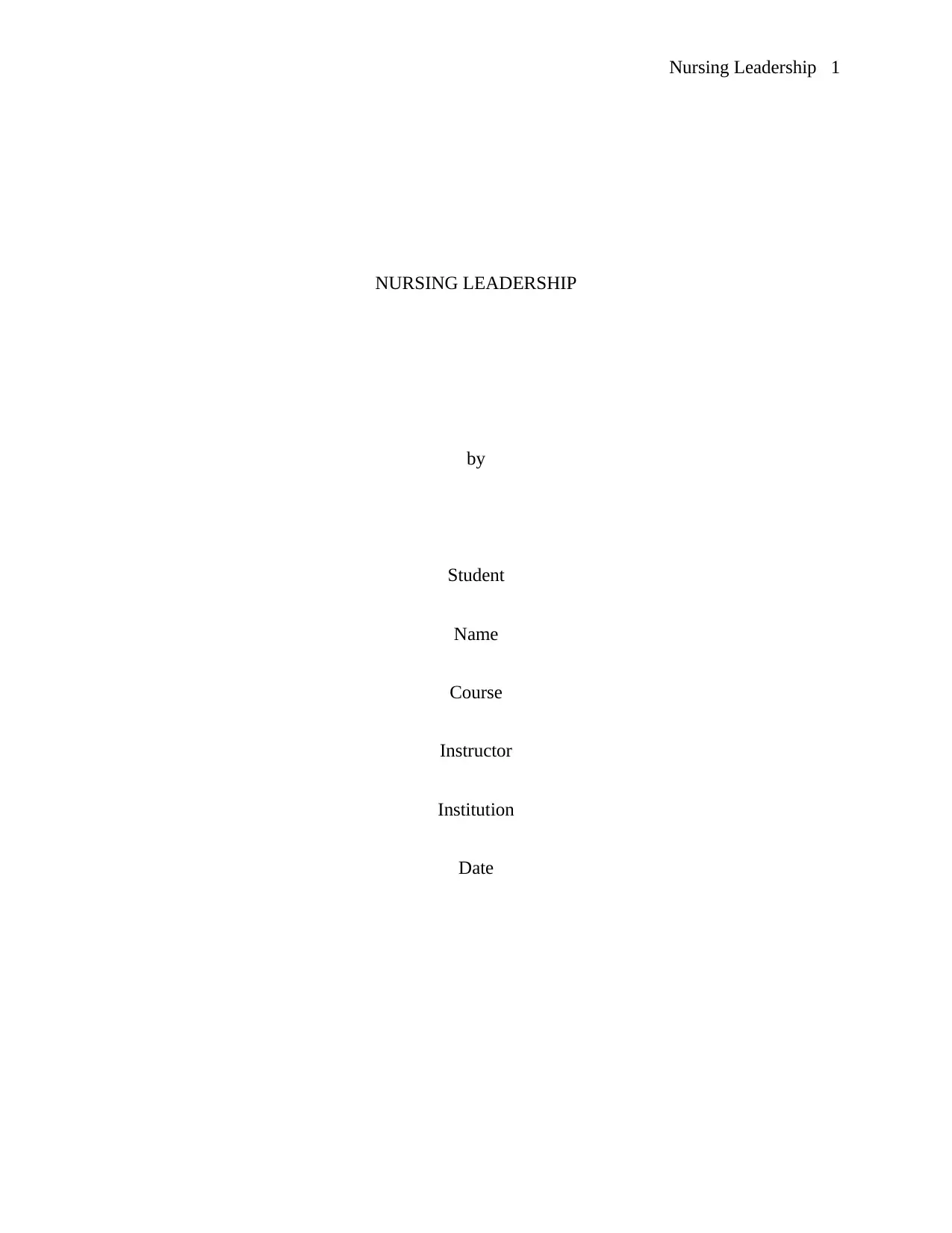
Nursing Leadership 1
NURSING LEADERSHIP
by
Student
Name
Course
Instructor
Institution
Date
NURSING LEADERSHIP
by
Student
Name
Course
Instructor
Institution
Date
Paraphrase This Document
Need a fresh take? Get an instant paraphrase of this document with our AI Paraphraser
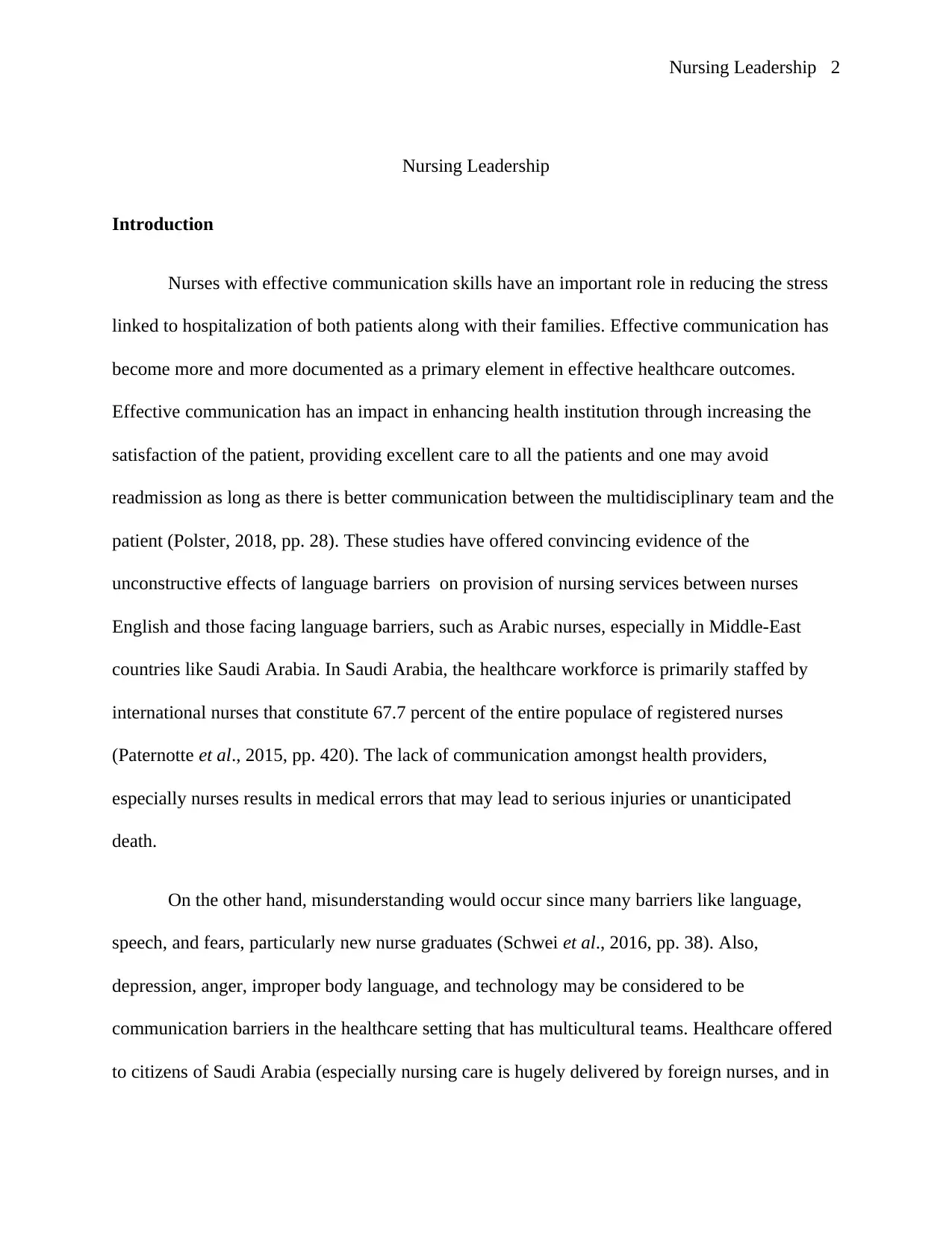
Nursing Leadership 2
Nursing Leadership
Introduction
Nurses with effective communication skills have an important role in reducing the stress
linked to hospitalization of both patients along with their families. Effective communication has
become more and more documented as a primary element in effective healthcare outcomes.
Effective communication has an impact in enhancing health institution through increasing the
satisfaction of the patient, providing excellent care to all the patients and one may avoid
readmission as long as there is better communication between the multidisciplinary team and the
patient (Polster, 2018, pp. 28). These studies have offered convincing evidence of the
unconstructive effects of language barriers on provision of nursing services between nurses
English and those facing language barriers, such as Arabic nurses, especially in Middle-East
countries like Saudi Arabia. In Saudi Arabia, the healthcare workforce is primarily staffed by
international nurses that constitute 67.7 percent of the entire populace of registered nurses
(Paternotte et al., 2015, pp. 420). The lack of communication amongst health providers,
especially nurses results in medical errors that may lead to serious injuries or unanticipated
death.
On the other hand, misunderstanding would occur since many barriers like language,
speech, and fears, particularly new nurse graduates (Schwei et al., 2016, pp. 38). Also,
depression, anger, improper body language, and technology may be considered to be
communication barriers in the healthcare setting that has multicultural teams. Healthcare offered
to citizens of Saudi Arabia (especially nursing care is hugely delivered by foreign nurses, and in
Nursing Leadership
Introduction
Nurses with effective communication skills have an important role in reducing the stress
linked to hospitalization of both patients along with their families. Effective communication has
become more and more documented as a primary element in effective healthcare outcomes.
Effective communication has an impact in enhancing health institution through increasing the
satisfaction of the patient, providing excellent care to all the patients and one may avoid
readmission as long as there is better communication between the multidisciplinary team and the
patient (Polster, 2018, pp. 28). These studies have offered convincing evidence of the
unconstructive effects of language barriers on provision of nursing services between nurses
English and those facing language barriers, such as Arabic nurses, especially in Middle-East
countries like Saudi Arabia. In Saudi Arabia, the healthcare workforce is primarily staffed by
international nurses that constitute 67.7 percent of the entire populace of registered nurses
(Paternotte et al., 2015, pp. 420). The lack of communication amongst health providers,
especially nurses results in medical errors that may lead to serious injuries or unanticipated
death.
On the other hand, misunderstanding would occur since many barriers like language,
speech, and fears, particularly new nurse graduates (Schwei et al., 2016, pp. 38). Also,
depression, anger, improper body language, and technology may be considered to be
communication barriers in the healthcare setting that has multicultural teams. Healthcare offered
to citizens of Saudi Arabia (especially nursing care is hugely delivered by foreign nurses, and in

Nursing Leadership 3
the mainstream is non-Arabic speaking, coming from diverse cultural backgrounds. The 2006
Ministry of Health Annual Report reported that Saudi Nurses comprise 27 percent of the nursing
workforce across the nation. This situation has resulted in linguistic diversity and large language
barriers between nurses and patients (Meuter et al., 2015, pp. 371).
The paper will examine the current state of communication, and impacts of language
barrier at King Abdullah bin Abdul-Aziz University Hospital (KAAUH). KAAUH is a hospital
facility that is situated in Riyadh, which is the capital city of kingdom Saudi Arabia. The facility
has multi-nationality staff such as South- African, Pilipino, Malaysian, Indian and Saudi nurses
that has resulted in ineffective communication among nurses resulting in poor quality service
delivery and miscommunication. Finally, the paper will provide recommendations towards
eliminating the language barrier at KAAUH.
Background/Current State
In King Abdullah bin Abdul-Aziz University Hospital (KAAUH) situated in Riyadh, the
capital city of Kingdom of Saudi Arabia (KSA) have multidimensional nurses, like Malaysian,
South Africans, Pilipino, Saudi, as well as Indian nurses. The mainstream of the nurses in the
hospital facility are Pilipino and the official languages in the hospital are either Arabic or
English. The hospital’s capacity is three hundred (300) beds because of the limited beds; the
hospital serves the students who are studying at Princes Nora University and the staff is under
KAAUH, or PNU. Consequently, many students want to be served by the hospital, but the
hospital limited spaces for the students and patients at the same time, which has made the
hospital to establish a University Medical Centre (UMC). UMC serve students in the region only
the mainstream is non-Arabic speaking, coming from diverse cultural backgrounds. The 2006
Ministry of Health Annual Report reported that Saudi Nurses comprise 27 percent of the nursing
workforce across the nation. This situation has resulted in linguistic diversity and large language
barriers between nurses and patients (Meuter et al., 2015, pp. 371).
The paper will examine the current state of communication, and impacts of language
barrier at King Abdullah bin Abdul-Aziz University Hospital (KAAUH). KAAUH is a hospital
facility that is situated in Riyadh, which is the capital city of kingdom Saudi Arabia. The facility
has multi-nationality staff such as South- African, Pilipino, Malaysian, Indian and Saudi nurses
that has resulted in ineffective communication among nurses resulting in poor quality service
delivery and miscommunication. Finally, the paper will provide recommendations towards
eliminating the language barrier at KAAUH.
Background/Current State
In King Abdullah bin Abdul-Aziz University Hospital (KAAUH) situated in Riyadh, the
capital city of Kingdom of Saudi Arabia (KSA) have multidimensional nurses, like Malaysian,
South Africans, Pilipino, Saudi, as well as Indian nurses. The mainstream of the nurses in the
hospital facility are Pilipino and the official languages in the hospital are either Arabic or
English. The hospital’s capacity is three hundred (300) beds because of the limited beds; the
hospital serves the students who are studying at Princes Nora University and the staff is under
KAAUH, or PNU. Consequently, many students want to be served by the hospital, but the
hospital limited spaces for the students and patients at the same time, which has made the
hospital to establish a University Medical Centre (UMC). UMC serve students in the region only
⊘ This is a preview!⊘
Do you want full access?
Subscribe today to unlock all pages.

Trusted by 1+ million students worldwide
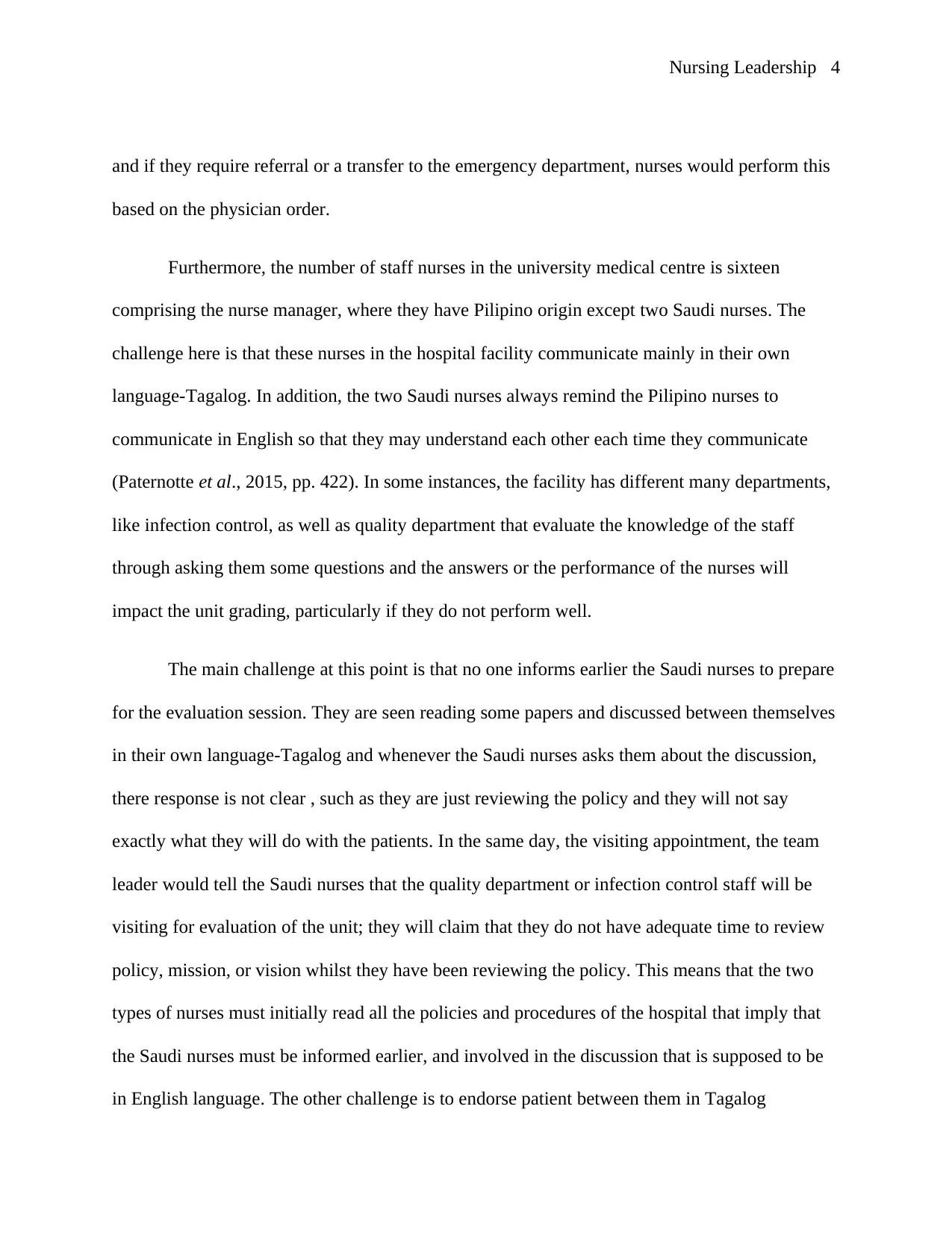
Nursing Leadership 4
and if they require referral or a transfer to the emergency department, nurses would perform this
based on the physician order.
Furthermore, the number of staff nurses in the university medical centre is sixteen
comprising the nurse manager, where they have Pilipino origin except two Saudi nurses. The
challenge here is that these nurses in the hospital facility communicate mainly in their own
language-Tagalog. In addition, the two Saudi nurses always remind the Pilipino nurses to
communicate in English so that they may understand each other each time they communicate
(Paternotte et al., 2015, pp. 422). In some instances, the facility has different many departments,
like infection control, as well as quality department that evaluate the knowledge of the staff
through asking them some questions and the answers or the performance of the nurses will
impact the unit grading, particularly if they do not perform well.
The main challenge at this point is that no one informs earlier the Saudi nurses to prepare
for the evaluation session. They are seen reading some papers and discussed between themselves
in their own language-Tagalog and whenever the Saudi nurses asks them about the discussion,
there response is not clear , such as they are just reviewing the policy and they will not say
exactly what they will do with the patients. In the same day, the visiting appointment, the team
leader would tell the Saudi nurses that the quality department or infection control staff will be
visiting for evaluation of the unit; they will claim that they do not have adequate time to review
policy, mission, or vision whilst they have been reviewing the policy. This means that the two
types of nurses must initially read all the policies and procedures of the hospital that imply that
the Saudi nurses must be informed earlier, and involved in the discussion that is supposed to be
in English language. The other challenge is to endorse patient between them in Tagalog
and if they require referral or a transfer to the emergency department, nurses would perform this
based on the physician order.
Furthermore, the number of staff nurses in the university medical centre is sixteen
comprising the nurse manager, where they have Pilipino origin except two Saudi nurses. The
challenge here is that these nurses in the hospital facility communicate mainly in their own
language-Tagalog. In addition, the two Saudi nurses always remind the Pilipino nurses to
communicate in English so that they may understand each other each time they communicate
(Paternotte et al., 2015, pp. 422). In some instances, the facility has different many departments,
like infection control, as well as quality department that evaluate the knowledge of the staff
through asking them some questions and the answers or the performance of the nurses will
impact the unit grading, particularly if they do not perform well.
The main challenge at this point is that no one informs earlier the Saudi nurses to prepare
for the evaluation session. They are seen reading some papers and discussed between themselves
in their own language-Tagalog and whenever the Saudi nurses asks them about the discussion,
there response is not clear , such as they are just reviewing the policy and they will not say
exactly what they will do with the patients. In the same day, the visiting appointment, the team
leader would tell the Saudi nurses that the quality department or infection control staff will be
visiting for evaluation of the unit; they will claim that they do not have adequate time to review
policy, mission, or vision whilst they have been reviewing the policy. This means that the two
types of nurses must initially read all the policies and procedures of the hospital that imply that
the Saudi nurses must be informed earlier, and involved in the discussion that is supposed to be
in English language. The other challenge is to endorse patient between them in Tagalog
Paraphrase This Document
Need a fresh take? Get an instant paraphrase of this document with our AI Paraphraser
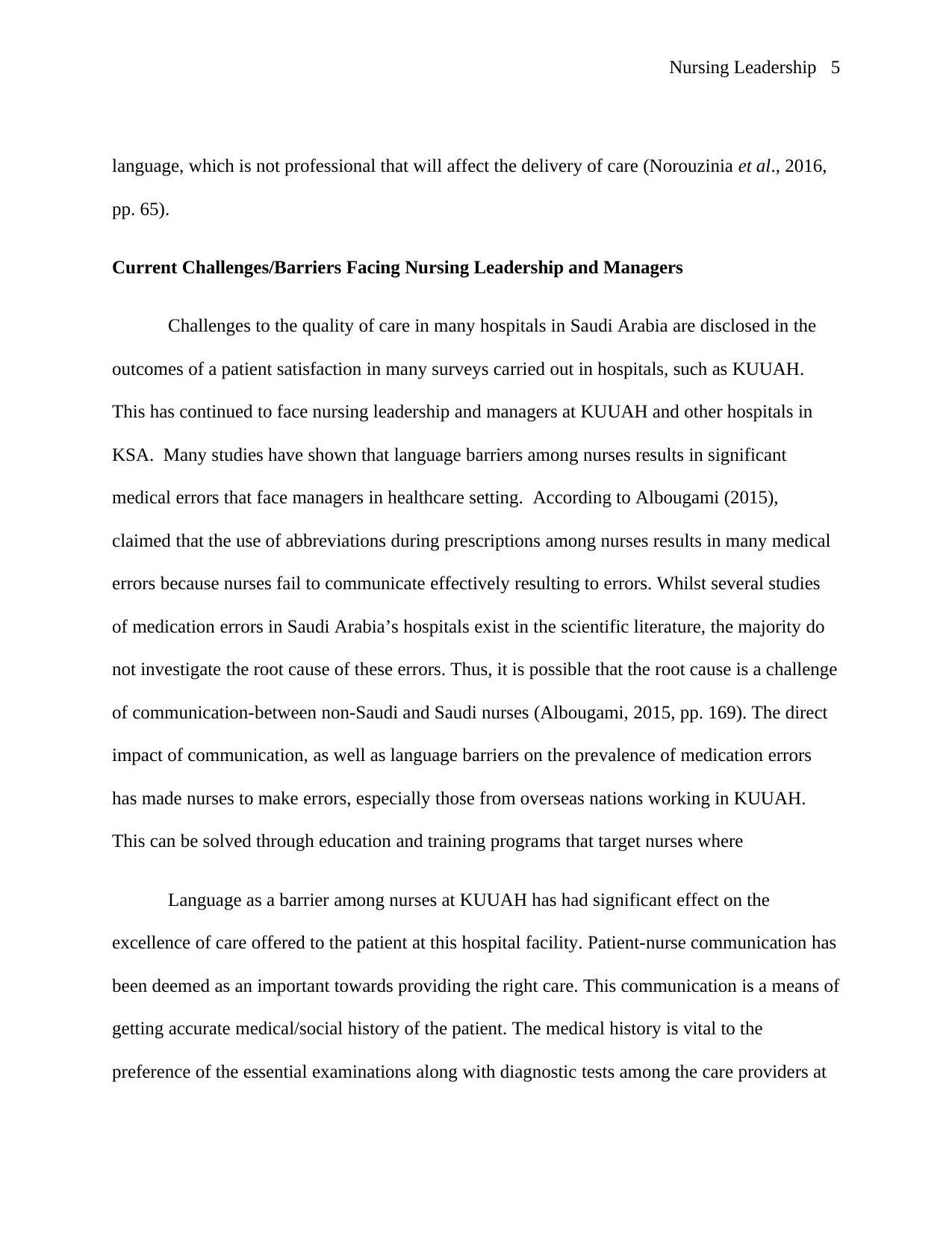
Nursing Leadership 5
language, which is not professional that will affect the delivery of care (Norouzinia et al., 2016,
pp. 65).
Current Challenges/Barriers Facing Nursing Leadership and Managers
Challenges to the quality of care in many hospitals in Saudi Arabia are disclosed in the
outcomes of a patient satisfaction in many surveys carried out in hospitals, such as KUUAH.
This has continued to face nursing leadership and managers at KUUAH and other hospitals in
KSA. Many studies have shown that language barriers among nurses results in significant
medical errors that face managers in healthcare setting. According to Albougami (2015),
claimed that the use of abbreviations during prescriptions among nurses results in many medical
errors because nurses fail to communicate effectively resulting to errors. Whilst several studies
of medication errors in Saudi Arabia’s hospitals exist in the scientific literature, the majority do
not investigate the root cause of these errors. Thus, it is possible that the root cause is a challenge
of communication-between non-Saudi and Saudi nurses (Albougami, 2015, pp. 169). The direct
impact of communication, as well as language barriers on the prevalence of medication errors
has made nurses to make errors, especially those from overseas nations working in KUUAH.
This can be solved through education and training programs that target nurses where
Language as a barrier among nurses at KUUAH has had significant effect on the
excellence of care offered to the patient at this hospital facility. Patient-nurse communication has
been deemed as an important towards providing the right care. This communication is a means of
getting accurate medical/social history of the patient. The medical history is vital to the
preference of the essential examinations along with diagnostic tests among the care providers at
language, which is not professional that will affect the delivery of care (Norouzinia et al., 2016,
pp. 65).
Current Challenges/Barriers Facing Nursing Leadership and Managers
Challenges to the quality of care in many hospitals in Saudi Arabia are disclosed in the
outcomes of a patient satisfaction in many surveys carried out in hospitals, such as KUUAH.
This has continued to face nursing leadership and managers at KUUAH and other hospitals in
KSA. Many studies have shown that language barriers among nurses results in significant
medical errors that face managers in healthcare setting. According to Albougami (2015),
claimed that the use of abbreviations during prescriptions among nurses results in many medical
errors because nurses fail to communicate effectively resulting to errors. Whilst several studies
of medication errors in Saudi Arabia’s hospitals exist in the scientific literature, the majority do
not investigate the root cause of these errors. Thus, it is possible that the root cause is a challenge
of communication-between non-Saudi and Saudi nurses (Albougami, 2015, pp. 169). The direct
impact of communication, as well as language barriers on the prevalence of medication errors
has made nurses to make errors, especially those from overseas nations working in KUUAH.
This can be solved through education and training programs that target nurses where
Language as a barrier among nurses at KUUAH has had significant effect on the
excellence of care offered to the patient at this hospital facility. Patient-nurse communication has
been deemed as an important towards providing the right care. This communication is a means of
getting accurate medical/social history of the patient. The medical history is vital to the
preference of the essential examinations along with diagnostic tests among the care providers at

Nursing Leadership 6
KAAUH. Thus, the communication among nurses speaking English dealing with Arabic patients
has provided a huge challenge in the facility towards delivery of care (Ramisetty-Mikler et al,
2015, pp. 229). This communication barrier compromise the influence of the medical interview,
frequently leading to augmented reliance of lab or imaging tests or erroneous test ordering.
Researches in mental health field have established that patients provide diverse responses to
questions based on language of interview. In many instances, communication barriers lead to
lower diagnostic self-confidence and higher propensity to order supplementary tests within the
hospital facility. Nurse leadership and managers may overcome this barrier through effective
policies and procedures. They should introduce strict penalties through policies for any staff who
use an unauthorized language and the nurse manager or the head of the department should
involve in that punishment. This will ensure that communication among the nurses is streamlined
as these penalties will make nurses to communicate in unauthorized language (Polster, 2018, pp.
29).
In addition, studies have established that even if the medical condition is properly
diagnosed, language barriers among nurses may result in poorer disease management, as well as
outcomes that continue to present challenges to managers and nursing leadership at KUUAH.
Many foreign nurses speaking mainly in English have differed with Arabic nurses in many
hospital facilities including KAAUH on the right methods of disease management because of
language barriers. It has been found that foreign nurses in the facility are less likely to provide
health and lifestyle counseling services because these nurses cannot understand fluently the
Tagalog language that results in poor disease management. This has affected patients suffering
from diabetes, heart attack, or hypertension. When a nurses are knowledgeable of the cultural
KAAUH. Thus, the communication among nurses speaking English dealing with Arabic patients
has provided a huge challenge in the facility towards delivery of care (Ramisetty-Mikler et al,
2015, pp. 229). This communication barrier compromise the influence of the medical interview,
frequently leading to augmented reliance of lab or imaging tests or erroneous test ordering.
Researches in mental health field have established that patients provide diverse responses to
questions based on language of interview. In many instances, communication barriers lead to
lower diagnostic self-confidence and higher propensity to order supplementary tests within the
hospital facility. Nurse leadership and managers may overcome this barrier through effective
policies and procedures. They should introduce strict penalties through policies for any staff who
use an unauthorized language and the nurse manager or the head of the department should
involve in that punishment. This will ensure that communication among the nurses is streamlined
as these penalties will make nurses to communicate in unauthorized language (Polster, 2018, pp.
29).
In addition, studies have established that even if the medical condition is properly
diagnosed, language barriers among nurses may result in poorer disease management, as well as
outcomes that continue to present challenges to managers and nursing leadership at KUUAH.
Many foreign nurses speaking mainly in English have differed with Arabic nurses in many
hospital facilities including KAAUH on the right methods of disease management because of
language barriers. It has been found that foreign nurses in the facility are less likely to provide
health and lifestyle counseling services because these nurses cannot understand fluently the
Tagalog language that results in poor disease management. This has affected patients suffering
from diabetes, heart attack, or hypertension. When a nurses are knowledgeable of the cultural
⊘ This is a preview!⊘
Do you want full access?
Subscribe today to unlock all pages.

Trusted by 1+ million students worldwide
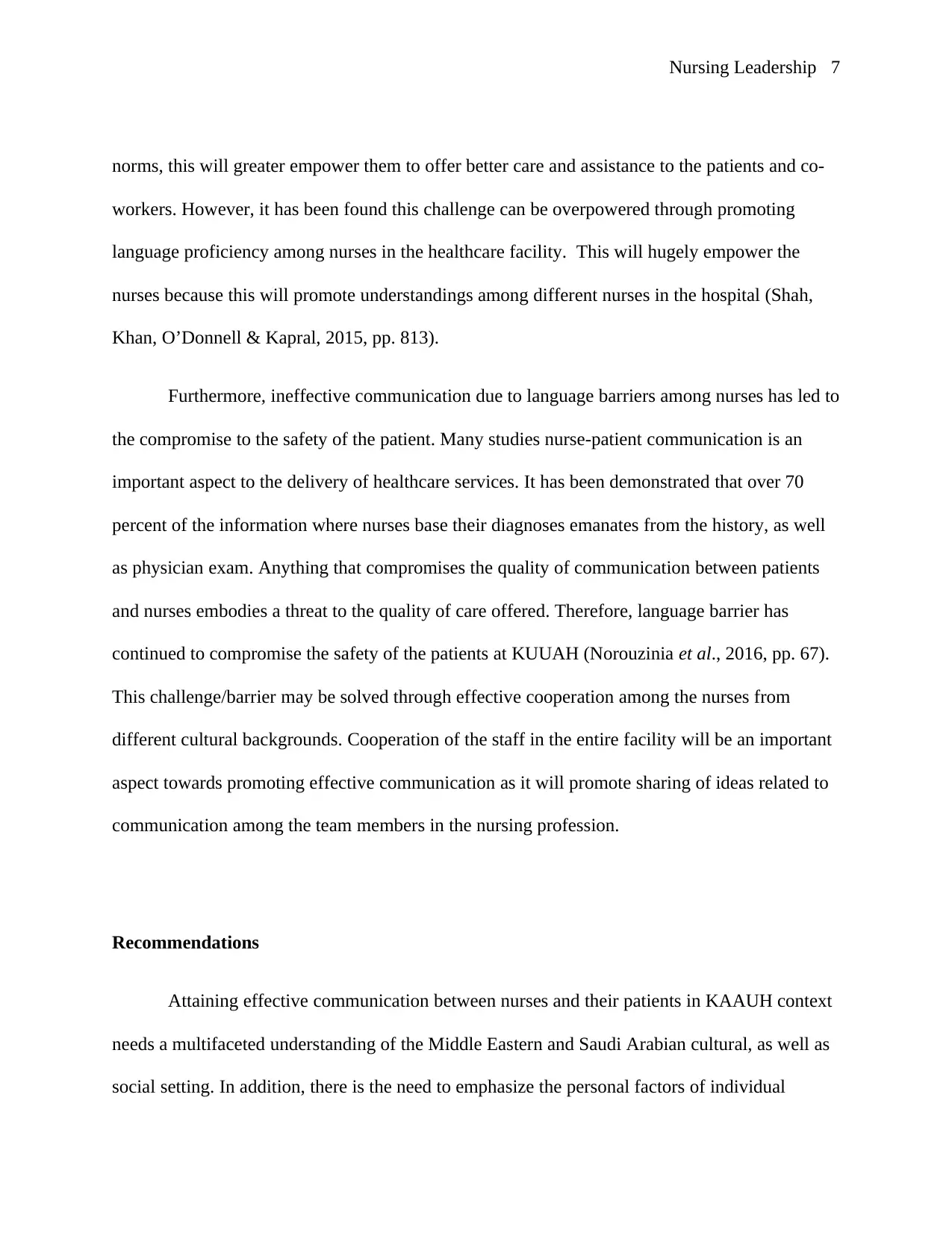
Nursing Leadership 7
norms, this will greater empower them to offer better care and assistance to the patients and co-
workers. However, it has been found this challenge can be overpowered through promoting
language proficiency among nurses in the healthcare facility. This will hugely empower the
nurses because this will promote understandings among different nurses in the hospital (Shah,
Khan, O’Donnell & Kapral, 2015, pp. 813).
Furthermore, ineffective communication due to language barriers among nurses has led to
the compromise to the safety of the patient. Many studies nurse-patient communication is an
important aspect to the delivery of healthcare services. It has been demonstrated that over 70
percent of the information where nurses base their diagnoses emanates from the history, as well
as physician exam. Anything that compromises the quality of communication between patients
and nurses embodies a threat to the quality of care offered. Therefore, language barrier has
continued to compromise the safety of the patients at KUUAH (Norouzinia et al., 2016, pp. 67).
This challenge/barrier may be solved through effective cooperation among the nurses from
different cultural backgrounds. Cooperation of the staff in the entire facility will be an important
aspect towards promoting effective communication as it will promote sharing of ideas related to
communication among the team members in the nursing profession.
Recommendations
Attaining effective communication between nurses and their patients in KAAUH context
needs a multifaceted understanding of the Middle Eastern and Saudi Arabian cultural, as well as
social setting. In addition, there is the need to emphasize the personal factors of individual
norms, this will greater empower them to offer better care and assistance to the patients and co-
workers. However, it has been found this challenge can be overpowered through promoting
language proficiency among nurses in the healthcare facility. This will hugely empower the
nurses because this will promote understandings among different nurses in the hospital (Shah,
Khan, O’Donnell & Kapral, 2015, pp. 813).
Furthermore, ineffective communication due to language barriers among nurses has led to
the compromise to the safety of the patient. Many studies nurse-patient communication is an
important aspect to the delivery of healthcare services. It has been demonstrated that over 70
percent of the information where nurses base their diagnoses emanates from the history, as well
as physician exam. Anything that compromises the quality of communication between patients
and nurses embodies a threat to the quality of care offered. Therefore, language barrier has
continued to compromise the safety of the patients at KUUAH (Norouzinia et al., 2016, pp. 67).
This challenge/barrier may be solved through effective cooperation among the nurses from
different cultural backgrounds. Cooperation of the staff in the entire facility will be an important
aspect towards promoting effective communication as it will promote sharing of ideas related to
communication among the team members in the nursing profession.
Recommendations
Attaining effective communication between nurses and their patients in KAAUH context
needs a multifaceted understanding of the Middle Eastern and Saudi Arabian cultural, as well as
social setting. In addition, there is the need to emphasize the personal factors of individual
Paraphrase This Document
Need a fresh take? Get an instant paraphrase of this document with our AI Paraphraser
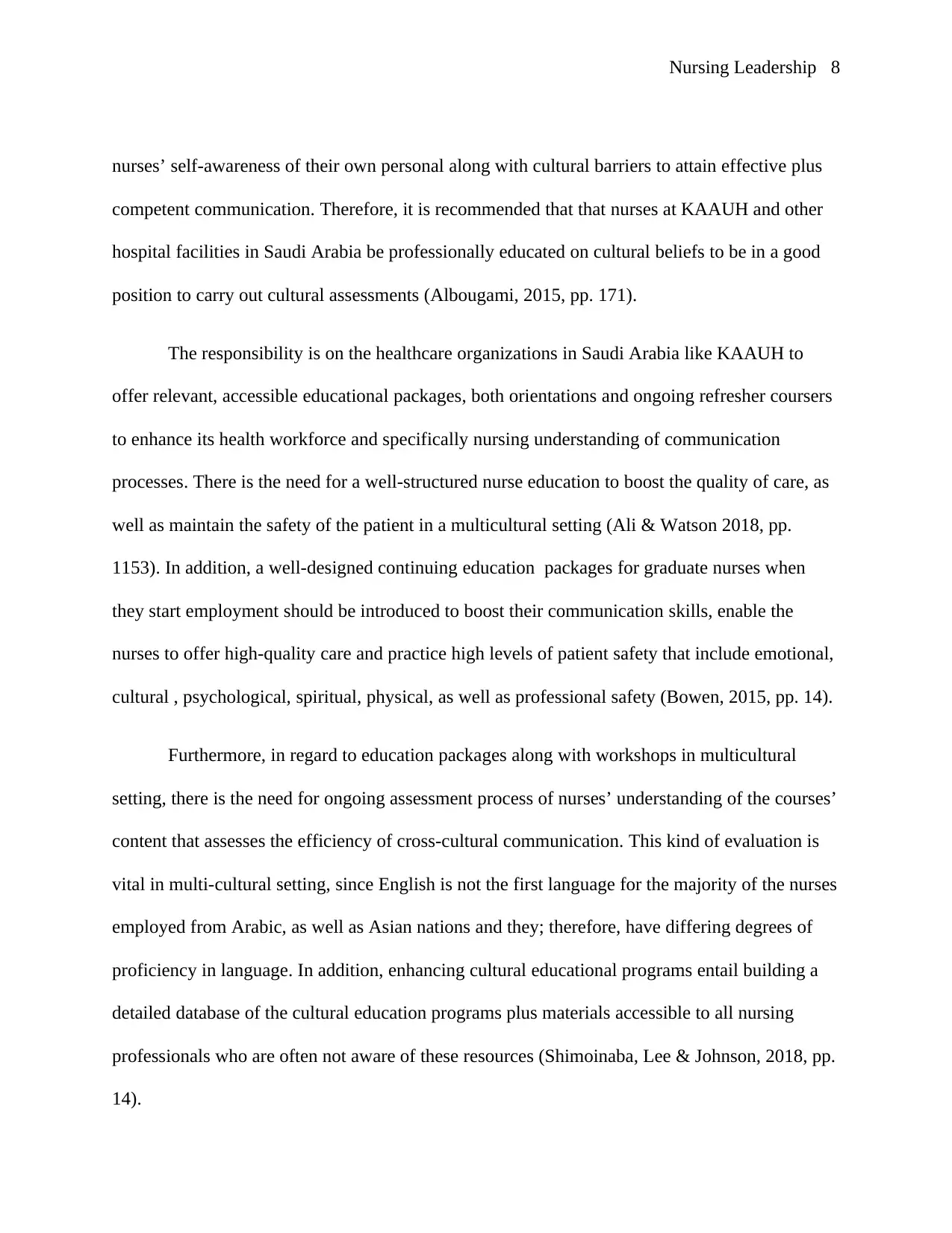
Nursing Leadership 8
nurses’ self-awareness of their own personal along with cultural barriers to attain effective plus
competent communication. Therefore, it is recommended that that nurses at KAAUH and other
hospital facilities in Saudi Arabia be professionally educated on cultural beliefs to be in a good
position to carry out cultural assessments (Albougami, 2015, pp. 171).
The responsibility is on the healthcare organizations in Saudi Arabia like KAAUH to
offer relevant, accessible educational packages, both orientations and ongoing refresher coursers
to enhance its health workforce and specifically nursing understanding of communication
processes. There is the need for a well-structured nurse education to boost the quality of care, as
well as maintain the safety of the patient in a multicultural setting (Ali & Watson 2018, pp.
1153). In addition, a well-designed continuing education packages for graduate nurses when
they start employment should be introduced to boost their communication skills, enable the
nurses to offer high-quality care and practice high levels of patient safety that include emotional,
cultural , psychological, spiritual, physical, as well as professional safety (Bowen, 2015, pp. 14).
Furthermore, in regard to education packages along with workshops in multicultural
setting, there is the need for ongoing assessment process of nurses’ understanding of the courses’
content that assesses the efficiency of cross-cultural communication. This kind of evaluation is
vital in multi-cultural setting, since English is not the first language for the majority of the nurses
employed from Arabic, as well as Asian nations and they; therefore, have differing degrees of
proficiency in language. In addition, enhancing cultural educational programs entail building a
detailed database of the cultural education programs plus materials accessible to all nursing
professionals who are often not aware of these resources (Shimoinaba, Lee & Johnson, 2018, pp.
14).
nurses’ self-awareness of their own personal along with cultural barriers to attain effective plus
competent communication. Therefore, it is recommended that that nurses at KAAUH and other
hospital facilities in Saudi Arabia be professionally educated on cultural beliefs to be in a good
position to carry out cultural assessments (Albougami, 2015, pp. 171).
The responsibility is on the healthcare organizations in Saudi Arabia like KAAUH to
offer relevant, accessible educational packages, both orientations and ongoing refresher coursers
to enhance its health workforce and specifically nursing understanding of communication
processes. There is the need for a well-structured nurse education to boost the quality of care, as
well as maintain the safety of the patient in a multicultural setting (Ali & Watson 2018, pp.
1153). In addition, a well-designed continuing education packages for graduate nurses when
they start employment should be introduced to boost their communication skills, enable the
nurses to offer high-quality care and practice high levels of patient safety that include emotional,
cultural , psychological, spiritual, physical, as well as professional safety (Bowen, 2015, pp. 14).
Furthermore, in regard to education packages along with workshops in multicultural
setting, there is the need for ongoing assessment process of nurses’ understanding of the courses’
content that assesses the efficiency of cross-cultural communication. This kind of evaluation is
vital in multi-cultural setting, since English is not the first language for the majority of the nurses
employed from Arabic, as well as Asian nations and they; therefore, have differing degrees of
proficiency in language. In addition, enhancing cultural educational programs entail building a
detailed database of the cultural education programs plus materials accessible to all nursing
professionals who are often not aware of these resources (Shimoinaba, Lee & Johnson, 2018, pp.
14).
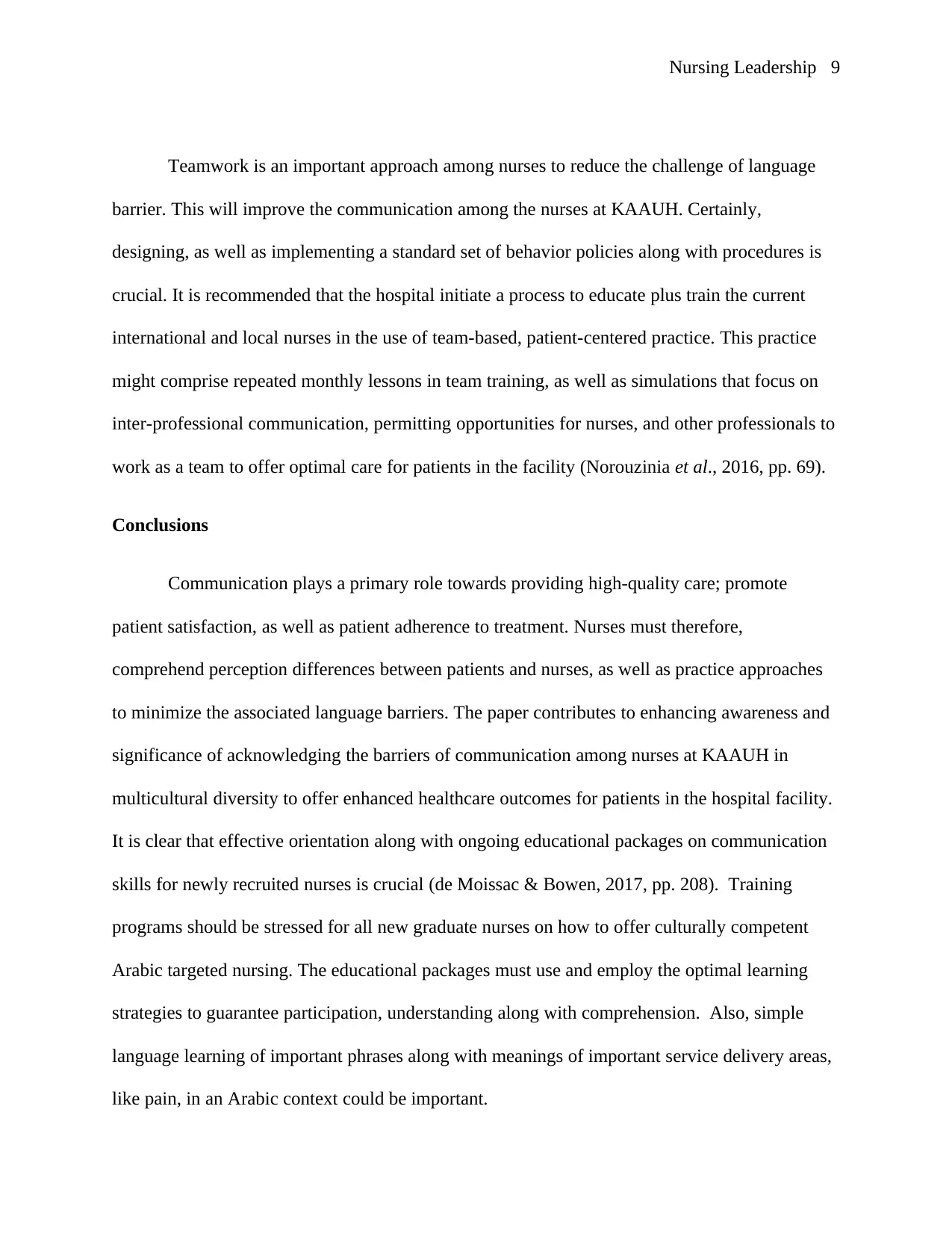
Nursing Leadership 9
Teamwork is an important approach among nurses to reduce the challenge of language
barrier. This will improve the communication among the nurses at KAAUH. Certainly,
designing, as well as implementing a standard set of behavior policies along with procedures is
crucial. It is recommended that the hospital initiate a process to educate plus train the current
international and local nurses in the use of team-based, patient-centered practice. This practice
might comprise repeated monthly lessons in team training, as well as simulations that focus on
inter-professional communication, permitting opportunities for nurses, and other professionals to
work as a team to offer optimal care for patients in the facility (Norouzinia et al., 2016, pp. 69).
Conclusions
Communication plays a primary role towards providing high-quality care; promote
patient satisfaction, as well as patient adherence to treatment. Nurses must therefore,
comprehend perception differences between patients and nurses, as well as practice approaches
to minimize the associated language barriers. The paper contributes to enhancing awareness and
significance of acknowledging the barriers of communication among nurses at KAAUH in
multicultural diversity to offer enhanced healthcare outcomes for patients in the hospital facility.
It is clear that effective orientation along with ongoing educational packages on communication
skills for newly recruited nurses is crucial (de Moissac & Bowen, 2017, pp. 208). Training
programs should be stressed for all new graduate nurses on how to offer culturally competent
Arabic targeted nursing. The educational packages must use and employ the optimal learning
strategies to guarantee participation, understanding along with comprehension. Also, simple
language learning of important phrases along with meanings of important service delivery areas,
like pain, in an Arabic context could be important.
Teamwork is an important approach among nurses to reduce the challenge of language
barrier. This will improve the communication among the nurses at KAAUH. Certainly,
designing, as well as implementing a standard set of behavior policies along with procedures is
crucial. It is recommended that the hospital initiate a process to educate plus train the current
international and local nurses in the use of team-based, patient-centered practice. This practice
might comprise repeated monthly lessons in team training, as well as simulations that focus on
inter-professional communication, permitting opportunities for nurses, and other professionals to
work as a team to offer optimal care for patients in the facility (Norouzinia et al., 2016, pp. 69).
Conclusions
Communication plays a primary role towards providing high-quality care; promote
patient satisfaction, as well as patient adherence to treatment. Nurses must therefore,
comprehend perception differences between patients and nurses, as well as practice approaches
to minimize the associated language barriers. The paper contributes to enhancing awareness and
significance of acknowledging the barriers of communication among nurses at KAAUH in
multicultural diversity to offer enhanced healthcare outcomes for patients in the hospital facility.
It is clear that effective orientation along with ongoing educational packages on communication
skills for newly recruited nurses is crucial (de Moissac & Bowen, 2017, pp. 208). Training
programs should be stressed for all new graduate nurses on how to offer culturally competent
Arabic targeted nursing. The educational packages must use and employ the optimal learning
strategies to guarantee participation, understanding along with comprehension. Also, simple
language learning of important phrases along with meanings of important service delivery areas,
like pain, in an Arabic context could be important.
⊘ This is a preview!⊘
Do you want full access?
Subscribe today to unlock all pages.

Trusted by 1+ million students worldwide
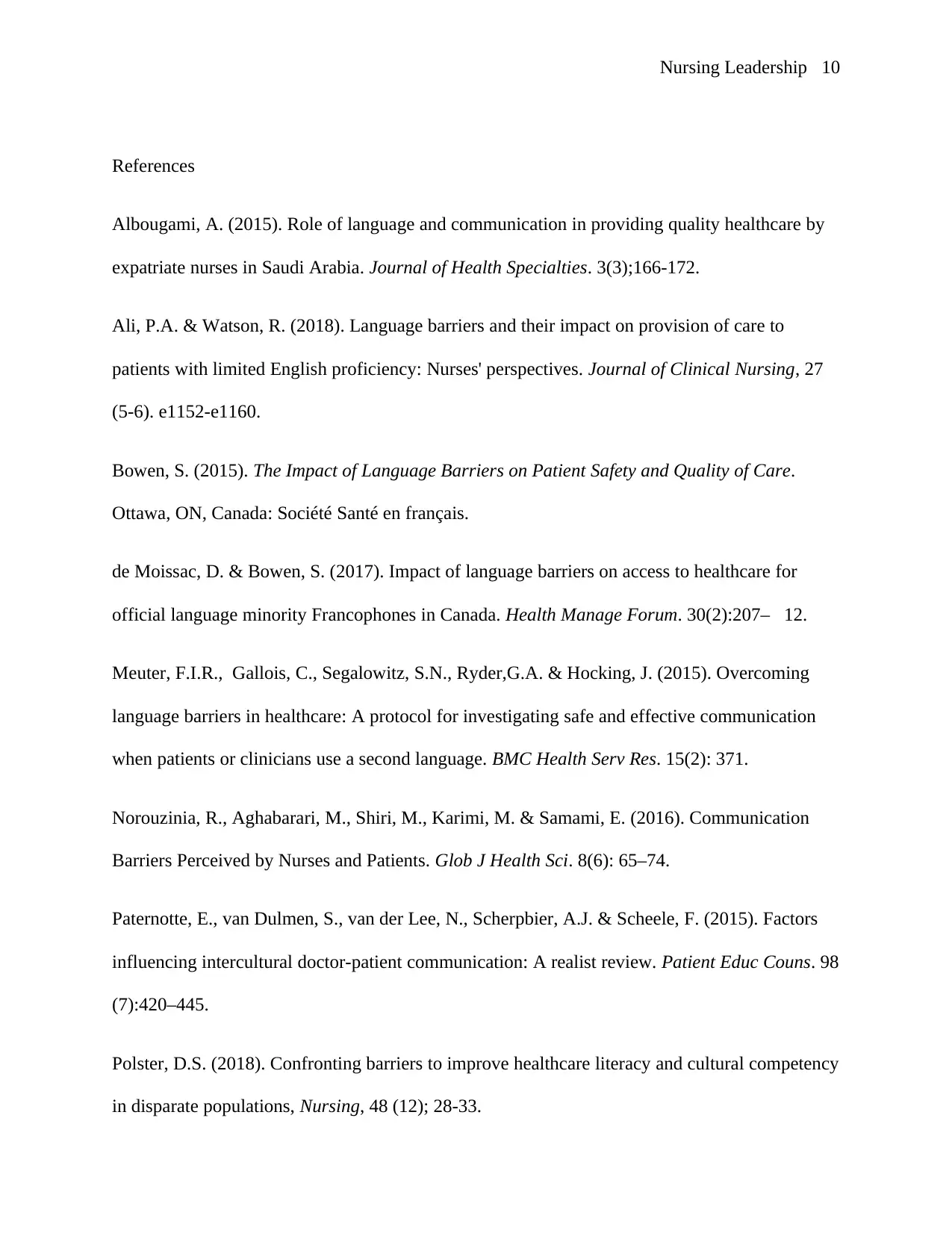
Nursing Leadership 10
References
Albougami, A. (2015). Role of language and communication in providing quality healthcare by
expatriate nurses in Saudi Arabia. Journal of Health Specialties. 3(3);166-172.
Ali, P.A. & Watson, R. (2018). Language barriers and their impact on provision of care to
patients with limited English proficiency: Nurses' perspectives. Journal of Clinical Nursing, 27
(5-6). e1152-e1160.
Bowen, S. (2015). The Impact of Language Barriers on Patient Safety and Quality of Care.
Ottawa, ON, Canada: Société Santé en français.
de Moissac, D. & Bowen, S. (2017). Impact of language barriers on access to healthcare for
official language minority Francophones in Canada. Health Manage Forum. 30(2):207– 12.
Meuter, F.I.R., Gallois, C., Segalowitz, S.N., Ryder,G.A. & Hocking, J. (2015). Overcoming
language barriers in healthcare: A protocol for investigating safe and effective communication
when patients or clinicians use a second language. BMC Health Serv Res. 15(2): 371.
Norouzinia, R., Aghabarari, M., Shiri, M., Karimi, M. & Samami, E. (2016). Communication
Barriers Perceived by Nurses and Patients. Glob J Health Sci. 8(6): 65–74.
Paternotte, E., van Dulmen, S., van der Lee, N., Scherpbier, A.J. & Scheele, F. (2015). Factors
influencing intercultural doctor-patient communication: A realist review. Patient Educ Couns. 98
(7):420–445.
Polster, D.S. (2018). Confronting barriers to improve healthcare literacy and cultural competency
in disparate populations, Nursing, 48 (12); 28-33.
References
Albougami, A. (2015). Role of language and communication in providing quality healthcare by
expatriate nurses in Saudi Arabia. Journal of Health Specialties. 3(3);166-172.
Ali, P.A. & Watson, R. (2018). Language barriers and their impact on provision of care to
patients with limited English proficiency: Nurses' perspectives. Journal of Clinical Nursing, 27
(5-6). e1152-e1160.
Bowen, S. (2015). The Impact of Language Barriers on Patient Safety and Quality of Care.
Ottawa, ON, Canada: Société Santé en français.
de Moissac, D. & Bowen, S. (2017). Impact of language barriers on access to healthcare for
official language minority Francophones in Canada. Health Manage Forum. 30(2):207– 12.
Meuter, F.I.R., Gallois, C., Segalowitz, S.N., Ryder,G.A. & Hocking, J. (2015). Overcoming
language barriers in healthcare: A protocol for investigating safe and effective communication
when patients or clinicians use a second language. BMC Health Serv Res. 15(2): 371.
Norouzinia, R., Aghabarari, M., Shiri, M., Karimi, M. & Samami, E. (2016). Communication
Barriers Perceived by Nurses and Patients. Glob J Health Sci. 8(6): 65–74.
Paternotte, E., van Dulmen, S., van der Lee, N., Scherpbier, A.J. & Scheele, F. (2015). Factors
influencing intercultural doctor-patient communication: A realist review. Patient Educ Couns. 98
(7):420–445.
Polster, D.S. (2018). Confronting barriers to improve healthcare literacy and cultural competency
in disparate populations, Nursing, 48 (12); 28-33.
Paraphrase This Document
Need a fresh take? Get an instant paraphrase of this document with our AI Paraphraser
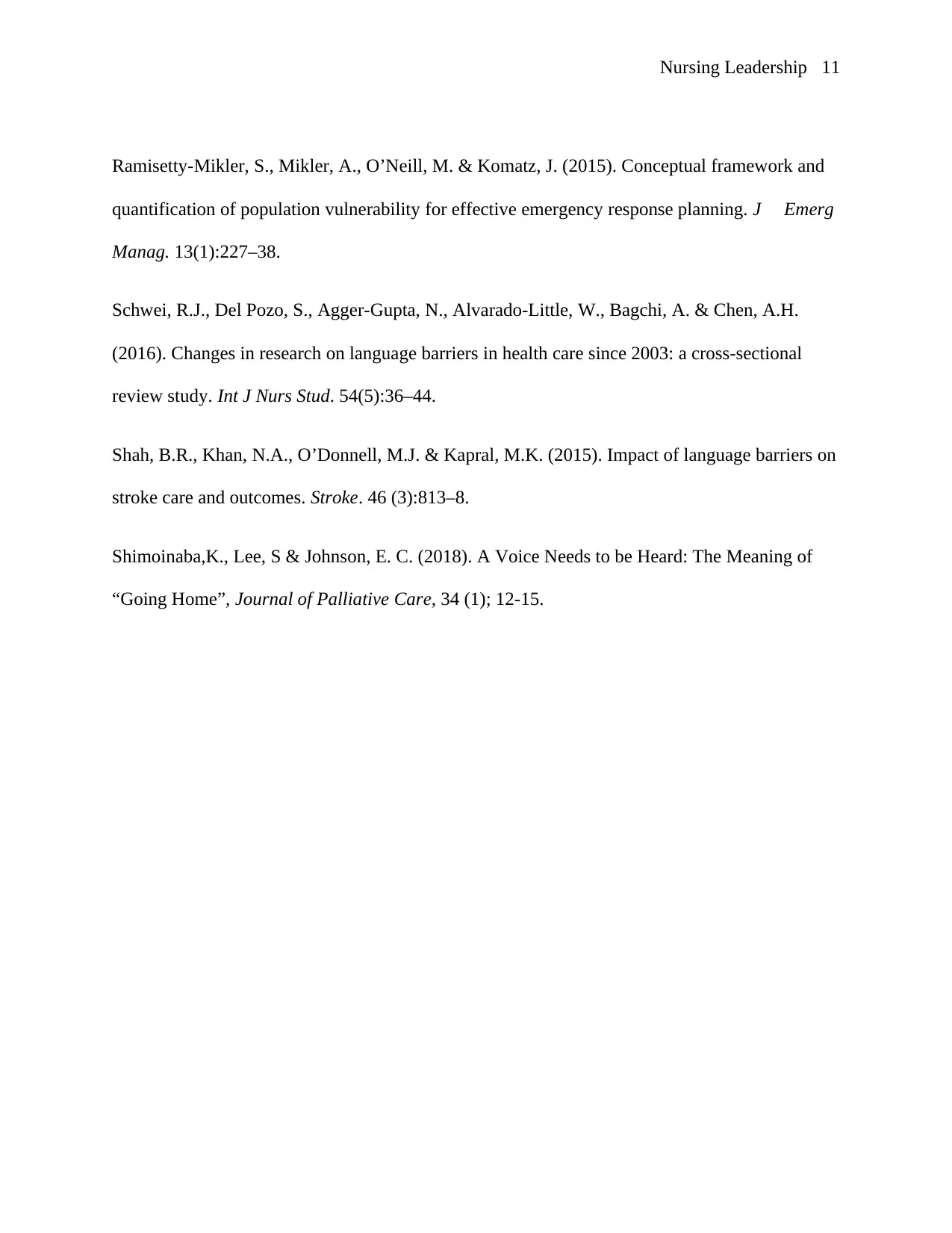
Nursing Leadership 11
Ramisetty-Mikler, S., Mikler, A., O’Neill, M. & Komatz, J. (2015). Conceptual framework and
quantification of population vulnerability for effective emergency response planning. J Emerg
Manag. 13(1):227–38.
Schwei, R.J., Del Pozo, S., Agger-Gupta, N., Alvarado-Little, W., Bagchi, A. & Chen, A.H.
(2016). Changes in research on language barriers in health care since 2003: a cross-sectional
review study. Int J Nurs Stud. 54(5):36–44.
Shah, B.R., Khan, N.A., O’Donnell, M.J. & Kapral, M.K. (2015). Impact of language barriers on
stroke care and outcomes. Stroke. 46 (3):813–8.
Shimoinaba,K., Lee, S & Johnson, E. C. (2018). A Voice Needs to be Heard: The Meaning of
“Going Home”, Journal of Palliative Care, 34 (1); 12-15.
Ramisetty-Mikler, S., Mikler, A., O’Neill, M. & Komatz, J. (2015). Conceptual framework and
quantification of population vulnerability for effective emergency response planning. J Emerg
Manag. 13(1):227–38.
Schwei, R.J., Del Pozo, S., Agger-Gupta, N., Alvarado-Little, W., Bagchi, A. & Chen, A.H.
(2016). Changes in research on language barriers in health care since 2003: a cross-sectional
review study. Int J Nurs Stud. 54(5):36–44.
Shah, B.R., Khan, N.A., O’Donnell, M.J. & Kapral, M.K. (2015). Impact of language barriers on
stroke care and outcomes. Stroke. 46 (3):813–8.
Shimoinaba,K., Lee, S & Johnson, E. C. (2018). A Voice Needs to be Heard: The Meaning of
“Going Home”, Journal of Palliative Care, 34 (1); 12-15.
1 out of 11
Your All-in-One AI-Powered Toolkit for Academic Success.
+13062052269
info@desklib.com
Available 24*7 on WhatsApp / Email
![[object Object]](/_next/static/media/star-bottom.7253800d.svg)
Unlock your academic potential
Copyright © 2020–2025 A2Z Services. All Rights Reserved. Developed and managed by ZUCOL.
